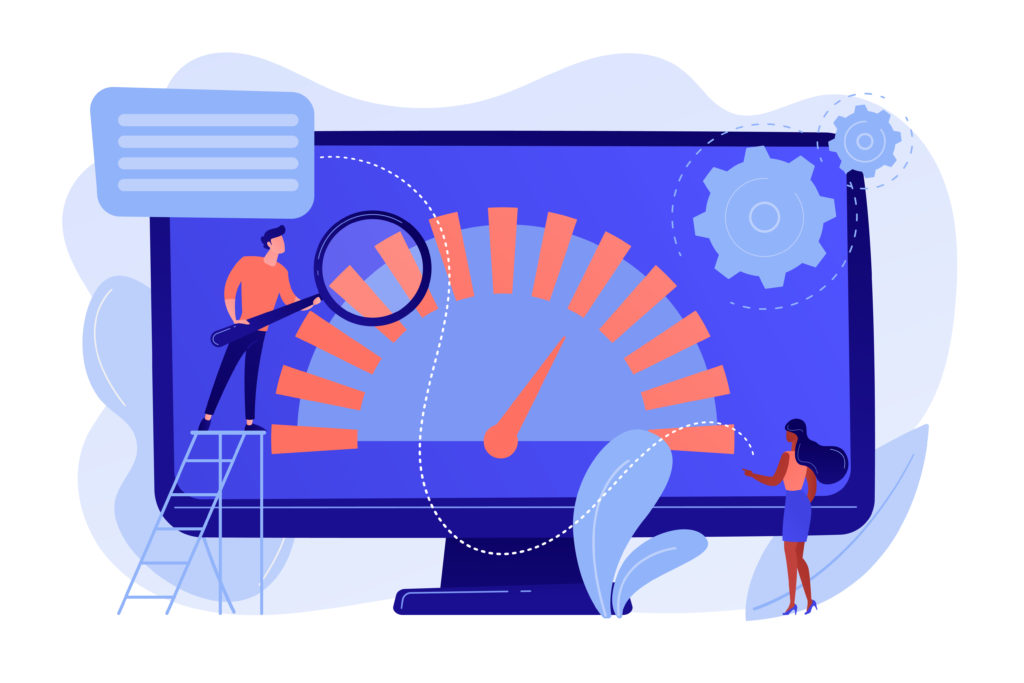If you’re a part of a contact center, you’d know the importance of your role in driving the company to success. But sometimes, even though the best service has been provided, the charts stay flat and don’t go up. There’s no drop in sales, but everything stays stagnant and can get quite frustrating to work with. What can we do in such situations?
A contact center focuses on customer interaction. Their functions include:
This is where performance metrics come into place. The data representative figures for the industry help to monitor, evaluate and determine actions. They also help in figuring out when and where to implement the constructed metrics. Also, know how they benefit you. No worries, we’ve got you covered for the Top 10 Contact Centre Performance Metrics to Track in 2021.

In general, performance metrics are data pools and statistics for a particular industry.
In a call center, performance metrics help track and gauge the total effectiveness of the customer service teams. Also known as KPIs, Key Performance Indicators are a type of Measurement. They check the level of fulfilling objectives. They cover various aspects, including customer satisfaction, agent productivity, and other such activities.
Knowing if the call center can reach the goals and solve customer issues can be quantifiable for specific objectives. It also works for an overall, comprehensive target. They are usually set to be accomplished and are hence sensibly attainable. On consideration, there are several reasons to track and watch performance metrics.
The critical difference between KPIs and metrics:

Any contact center that has well-defined goals needs planned out metrics to help achieve them in steps. Once the strategies have been established, performance measurement with KPIs and metrics can be used.
It is crucial to track the progress to find the areas of success and where one’s lacking. Using performing metrics means to compare, plan and set objectives. These help in the improvement and forward movement of the center.
There are four essential things to look at before developing Key Performance Indicators (KPIs). The Measurement of the number of customers, number of them satisfied, number of them who returned, etc., helps answer quantity questions. The Frequency of Measurement helps one fix the dates for checking the success. For each performance metric, it can be daily, weekly, monthly, or yearly.
The Source indicates the tool used for getting the data analytics and reports. Some contact centre performance metrics tracking tools include:
The Target is the number you need to reach on a timely basis, be it a month, semi-annual, or annual. Once set, it is essential to understand how they progress and compare with previous data. In a contact center where communication is key, there are several challenges one can face. This happens while settings and achieving the metrics.
Helps sales representatives work better
If the management and authority use procured data effectively, it helps sales agents work. Now they know what’s already there rather than having to guess. With proper evaluation, there can be enough feedback, information, guidance, and solutions. This helps them work like experts. With better skills, they can now handle complex interactions with ease. The potential statistical data can be valuable to customer satisfaction as well.
Helps contact centers with monitoring
Metrics ease the process of planning with backed-up data and setting necessary baselines. They also identify key areas of improvement and thereby improve productivity. Metrics foster consistent schedules that are effective. They also help in integrating the functioning of the whole contact center.
Increased productivity and functioning
Call centers remain critical windows for any business to succeed. This is because the company’s reputation and customer loyalty are on the line. But with well-established metrics, it is easy to identify any reason for stagnance, dropping, or even success. Now the company can be represented well with better responses.
Ensure consistency in service
By tracking performance metrics, contact centers can be alerted with updates and progress. This can identify any risks or areas of frustration and customer satisfaction. They can now pinpoint practices that work well and identify those that don’t persuade customers well enough.
Keep everything compliant
They help create compliance requirements for agents. Now they can be monitored to avoid any litigation. If necessary, there can be intervention to help with better performance. As metrics create versatile goals for the center, all agents have something to strive for.
Helps with morale and improves motivation
By increasing the morale in the center, representatives tend to feel more loyal to work. Having a goal to achieve pushes their loyalty to effective performance. They can thereby accomplish goals better now.
Give timely information to avoid temporal bias
Now instead of having to predict, contact centers can compare with previous statistics. This can give them insights to help them adapt to strategies that work with shifts and changes in the market. Now you can ensure a competitive edge in the market for the whole business.
Aligns atrocities for long term targets
Now that metrics have established organizational goals, the Measurement of effectiveness can help in instant development. With meaningful benchmarks, contact centers can ensure equitable treatment and consistent quality. They also create room for long-term objectives to work on along the way.
Since there are several attributes to consider before fixing KPIs, here are a few. These can help cover scalability, efficiency, and increase performance:
While trying to make scalable KPIs, it is essential to look at segments that define your goals. Actionable goals can’t be generic. They need to be specific to the business industry and the call center. For call centers, these help with perfecting KPIs:
Limecall acts as an efficient provider and tracks calls with best-in-class online numbers. Our service also helps you establish and achieve your metrics goals with dedicated teams at your service.

Specific to call centers, all goals are usually business-oriented. They focus on delivering efficiency, service, and increasing conversion. There are various ways to measure metrics and thereby many forms for:
Metrics chosen should help with effectiveness that measures performance, productivity, and satisfaction. They help monitor the data and help executives track their performance with comprehension.
The call abandonment rate shows the average number of calls that have been cut. This can be in the midst of service or while on hold time. If your contact center can’t hold them online to listen, it is impossible to convert callers to customers. Even the calls hung up before answering are a sign of low-quality service. This helps you identify every individual agent’s productivity and track to improve progress.
Even though this is a common occurrence, it is essential to try decreasing it. Looking at the calls blocked and the number that gets routed to voicemail or her an engaged tone. Depending on the software used and the network used, the metric can be fulfilled.
2. Average Time in Queue and Handle Time:
As customer service goes, the call needs to be redirected from agent to agent to help them avail the exemplary service. The hold time can be significant redundancy to customers ss they’re long and can be of little to no use. This also helps increase productivity by ensuring better customer service, especially when they hold monotonous tones with no interaction.
Tracking the average call time per agent helps find the efficiency. Even though the metric is quite tricky, it is essential. Shorter times mean carelessness, while long call times are tiring and confusing for both. While transfer time needs to be short, handle time needs to be just right.
3. Customer Satisfaction:
The metric is comprehensive and practical to score directly. Customer satisfaction is determined through surveys after calls and follow-up messages. With them, call centers can understand both general and specific performance. Happy customers do profitable businesses. Offering customers a scale for rating gives you an idea of representatives’ service.
This KPI can be acquired from many sources, and the acquisition is not only through surveys. Customer satisfaction can also measure from different other metrics such as conversions and call time. Even though it seems like a cliché, it is one of the best metrics to track as it is directly proportional to better profits.
4. After Call Work Time:
The average after-call work Time helps track and measure every agent’s time taken to finish work associated with the call. The work needs to be completed thoroughly and hence requires enough time and can’t take up a lot. This KPI can be calculated by adding the talk time, hold queue, and the rest of the after-call duties. Quality training and personal coaching for product knowledge and service specifications are necessary. It also helps agents get familiar with their duties. This efficiently reduces the time taken and increases the number of calls handled.
5. Speed of answering:
In a specific period, the time it takes for receptionists to answer incoming calls, transfer them, and also for agents to accept calls. This metric is essential to track as it helps to check the efficiency and speed of the agents. No one wants to wait around and slower service, in turn, helps you serve customers better. If the metric is high, it is important to analyze what’s keeping them from fitting the time frame.
6. Service Level:
Service level helps monitor agents in real-time. It is the calculated percentage of calls answered within a specific time. Keeping this KPI within the proper range is essential for contact centers. This prevents unplanned service outrages, frequent absences, and high call volume. For outsourced call centers, there are consequences when it comes to service level compensation. Dividing the total number of calls by the number of the abandoned calls gives you the number. Multiplying it by 100 gives you the service level percentage. This can be calculated as a whole or for every representative individually.
7. First Response Time and First Call Resolution:
The response time is a metric that is proportional to customer satisfaction. First responses matter. Tracking the percentage of calls that are successful in solving issues or converting leads to sales helps. This is one of the most important as a lower transfer rate is favorable for customer satisfaction.
It is clear to resolve productiveness as multiple lines and frequent transfers must be eliminated to keep the customer hooked. First-call resolutions reduce the effort on both sides. It can be measured by dividing the number of successfully resolved issues in a single call by the number of issues that need handling.
8. Occupancy and Utilization Rate:
Occupancy metrics help calculate the time agents are working with calls. This can help identify the overall work done by agents and how they manage time. This also includes working after to finish the task. The productivity of the duties needs time, and lower Occupancy rates can signify the necessity for improvement. Optimizing these rates help with the workload and assigning calls.
Utilization rate helps you understand the number of hours the agent has reached out of their work hours. The percentage is usually calculated to ensure that all executives are working well for contact centers.
9. Average Transfer Rate:
This KPI monitors the number of calls that get transferred from one cell line to another. This usually depends on the need of different department agents or the supervisor. Too many transfers are not suitable for customers, and the time for transfer needs to be short. Playing monotonous hold tones during the time can be a bad idea for contact centers.
A contact center should know how to manage to transfer well, either from one agent to another or the automated menu option. They must help in navigation and provide clear service for callers. Using a well-connected virtual number can help with decreasing the metric.
10. Customer Retention Rate:
Contrasting the call abandonment rate, the customer retention rate works with agent churn rates. They encompass the percentage of existing callers who remain the same after a given period. This metric can be calculated monthly, semi-annually, or annually. The churn rate refers to the customers lost. It can be determined by comparing the pools of customers after the required time.
Together, they help see how efficiently agents can retain customers, not only convert callers to new customers. They are indirectly proportional, and it is important to increase the retention rate. To help with this, contact centers need to have innovative retention and persuasion strategies to keep customers.

A simple solution for businesses to go by is outsourcing their call management. Hiring companies with expert contact centers and agents is beneficial. Use retail employee attrition and contact center features for ideas and to improve. “Create career paths. Foster feedback sessions,” says Don Peppers.
Management checklists for agents are not only important but are great for customer service as well. Employee-specific checklists hold value and help in providing feedback. They also personalize the connection between the management and sales representatives. “Each time managers perform a monitoring checklist and sit down with a particular employee, valuable to became much less to the manager, and much more of a value to that agent,” says Dan Coen, Call Center Today.
Contact centers are important for businesses to communicate with customers. But they also open a wide range of opportunities for conversions, retention, and progression. Hence, ensuring quality and development is inevitable. In such centers, everything has to be tracked with several performance metrics. They should also be tailor-made for your organization.
Limecall is one of the leading service providers for online numbers, call tracking and customer service for your business. Their services include:
, September 1, 2021, Team LimeCall

Top rated callback automation platform that connects your website visitors to your team within 20 seconds through phone callback and whatsapp driving upto 40% more conversions.
Learn more